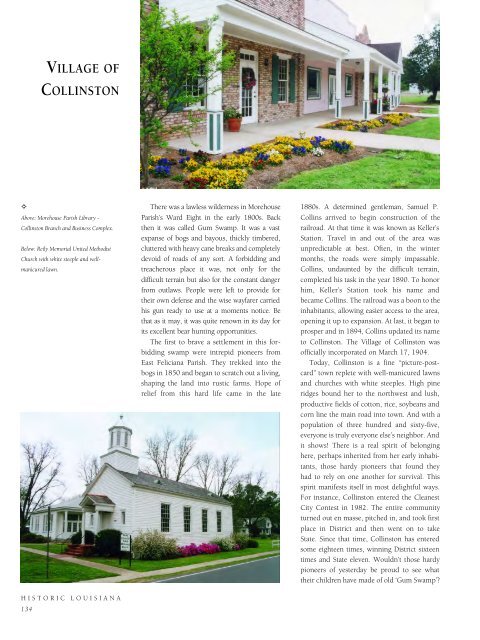Historic Louisiana
An illustrated history of Louisiana, paired with the histories of companies, families and organizations that make the state great.
An illustrated history of Louisiana, paired with the histories of companies, families and organizations that make the state great.
Create successful ePaper yourself
Turn your PDF publications into a flip-book with our unique Google optimized e-Paper software.
VILLAGE OF<br />
COLLINSTON<br />
✧<br />
Above: Morehouse Parish Library -<br />
Collinston Branch and Business Complex.<br />
Below: Reily Memorial United Methodist<br />
Church with white steeple and wellmanicured<br />
lawn.<br />
HISTORIC LOUISIANA<br />
134<br />
There was a lawless wilderness in Morehouse<br />
Parish’s Ward Eight in the early 1800s. Back<br />
then it was called Gum Swamp. It was a vast<br />
expanse of bogs and bayous, thickly timbered,<br />
cluttered with heavy cane breaks and completely<br />
devoid of roads of any sort. A forbidding and<br />
treacherous place it was, not only for the<br />
difficult terrain but also for the constant danger<br />
from outlaws. People were left to provide for<br />
their own defense and the wise wayfarer carried<br />
his gun ready to use at a moments notice. Be<br />
that as it may, it was quite renown in its day for<br />
its excellent bear hunting opportunities.<br />
The first to brave a settlement in this forbidding<br />
swamp were intrepid pioneers from<br />
East Feliciana Parish. They trekked into the<br />
bogs in 1850 and began to scratch out a living,<br />
shaping the land into rustic farms. Hope of<br />
relief from this hard life came in the late<br />
1880s. A determined gentleman, Samuel P.<br />
Collins arrived to begin construction of the<br />
railroad. At that time it was known as Keller’s<br />
Station. Travel in and out of the area was<br />
unpredictable at best. Often, in the winter<br />
months, the roads were simply impassable.<br />
Collins, undaunted by the difficult terrain,<br />
completed his task in the year 1890. To honor<br />
him, Keller’s Station took his name and<br />
became Collins. The railroad was a boon to the<br />
inhabitants, allowing easier access to the area,<br />
opening it up to expansion. At last, it began to<br />
prosper and in 1894, Collins updated its name<br />
to Collinston. The Village of Collinston was<br />
officially incorporated on March 17, 1904.<br />
Today, Collinston is a fine “picture-postcard”<br />
town replete with well-manicured lawns<br />
and churches with white steeples. High pine<br />
ridges bound her to the northwest and lush,<br />
productive fields of cotton, rice, soybeans and<br />
corn line the main road into town. And with a<br />
population of three hundred and sixty-five,<br />
everyone is truly everyone else’s neighbor. And<br />
it shows! There is a real spirit of belonging<br />
here, perhaps inherited from her early inhabitants,<br />
those hardy pioneers that found they<br />
had to rely on one another for survival. This<br />
spirit manifests itself in most delightful ways.<br />
For instance, Collinston entered the Cleanest<br />
City Contest in 1982. The entire community<br />
turned out en masse, pitched in, and took first<br />
place in District and then went on to take<br />
State. Since that time, Collinston has entered<br />
some eighteen times, winning District sixteen<br />
times and State eleven. Wouldn’t those hardy<br />
pioneers of yesterday be proud to see what<br />
their children have made of old ‘Gum Swamp’?
















